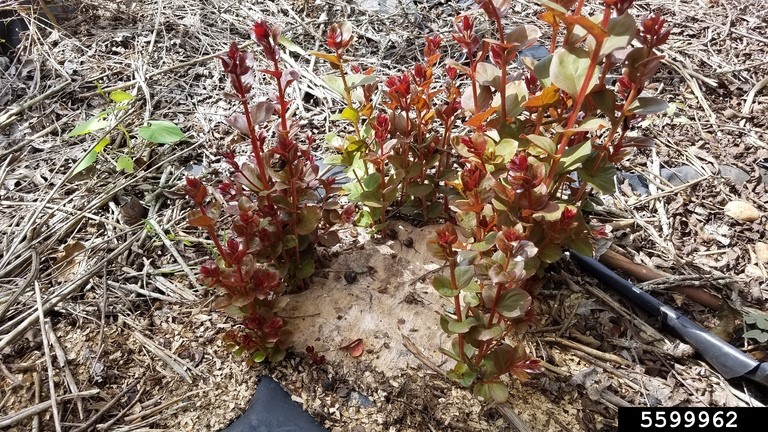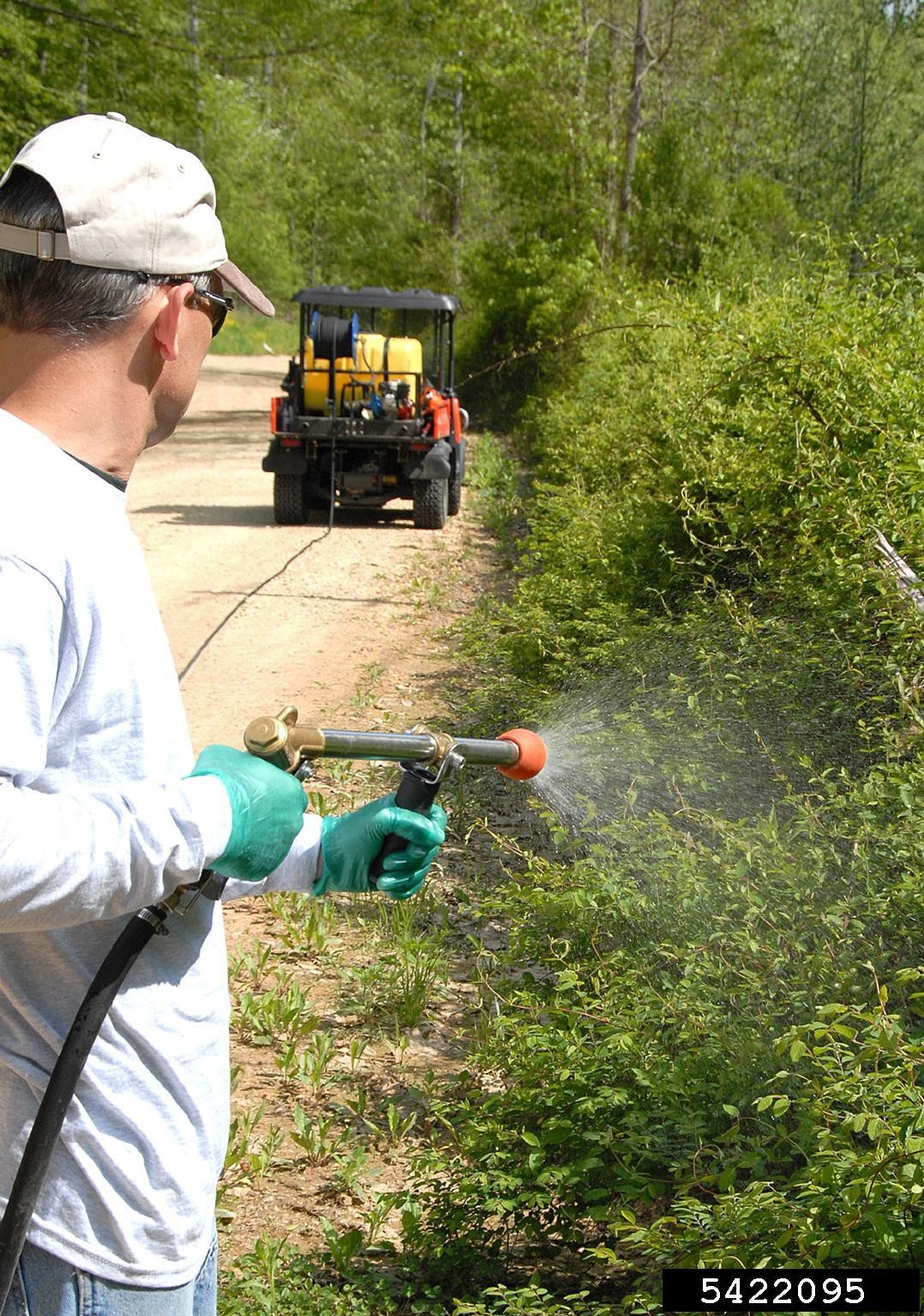Issue 4, June 1, 2021
Use of Herbicide in Natural Settings
To some, the idea of using herbicides in “natural” settings may seem a little ironic, but in fact herbicides are a useful and valuable tool for land owners and managers. Natural areas including woodlands, prairies, and even hedgerows in urban landscapes can be overtaken by invasive weeds – which are also “natural”. Weeds can alter ecosystems and rob sunlight, water, and nutrients from desirable plants which affects their growth and yield. In this article, we will discuss the pros and cons of herbicide use in these areas, alternative methods of weed control, and common application methods. Of course we typically recommend that non-chemical methods be implemented first before resorting to using herbicides.
Hand or physical removal can result in instant gratification but there may be limitations. Perhaps you have many more weeds than workers. Perhaps the weeds can’t be reached due to their location or perhaps they must be handled carefully due to possible dermal reactions, which is the case with wild parsnip and poison ivy. Others may have thorns or prickles such as multiflora rose or bull thistle, or an abundance of pollen such as ragweed. Hand digging or grubbing doesn’t always result in effective control or it may not be possible to remove all the roots. This is certainly the case with larger woody species but even with rhizomatous, perennial spreaders such as Canada thistle or quackgrass. Many of us have experienced the joy of digging up these weeds only to feel the snap of the rhizomes break off and know then that growth will soon return. We may be limited in our physical abilities and physical removal can result in sore muscles. We can use large equipment such as cutters and mowers, but certain woody species will send up shoots after cutting. Often cutting must be repeated and that’s time consuming. Large areas or infestations can require many, many man-hours.
Herbicides also have pros and cons. These can be used after cutting to prevent new sprouts and provide a more complete kill. They can also provide long lasting, selective, quick control in an efficient manner. Of course this is product dependent. Some herbicides are slower acting than others and some do not provide residual control but instead affect just the weeds present at application. Residual can be good and bad and there are uses for both types. Herbicides are often less labor intensive, less time consuming, and more economical. However, they are not suitable for every situation and off-target movement can occur. This is where the herbicide moves out of the area intended for application and can cause injury.

Untreated stump with sprouts. Rebekah D. Wallace, University of Georgia, Bugwood.org.
Off-target movement can result in much damage to desirable vegetation, humans, and wildlife if we are careless or if weather conditions are not appropriate. It could happen on your property or worse yet on the neighbor’s. Drift can be extremely expensive with fines and legal counsel. Pesticides become environmental hazards when they move off-target. Ideally, a pesticide should affect only the target pests and persist no longer than necessary to control them. Problems occur when pesticides are used in a manner that differs from what’s directed on the label or when spills occur. Unfortunately, this isn’t a new problem. As long as we’ve had herbicides, we’ve had off-target movement. Pesticides can help or harm the environment so it’s important for users to be aware of the environmental risks and use practices that minimize adverse effects.
An integrated approach is recommended and referred to as Integrated Pest Management or IPM. The most efficient and successful weed-control programs will include the use of nonchemical controls. These can include cultural controls such as controlling weeds early before they set seed which prevents future weeds, covering bare soil with mulch or groundcovers, using weed free materials to avoid introducing weeds, and cleaning equipment to prevent weed spread. Other methods include controlled burning, biological controls, and mechanical controls including mowing, cutting, girdling, and grubbing. For more effective control, a herbicide may be used immediately following some of these methods.
Herbicides are registered and labeled for legal use in specific areas. The application method or methods will be specified in the label directions. Herbicides can be applied a variety of ways and at different times of year. One very common way would be to the leaves called a foliar application. Also, the bark or cut stumps can be treated and herbicide can be injected into stems or applied to the soil. The method you choose depends on many factors including your target weed, the site, the time of year, available equipment, and the herbicide. Consult with the label for guidance while planning any control effort.
Some herbicides can be applied to the leaves. This type of application should be limited to herbaceous plants, SMALL trees, and shrubs as there is increased drift potential with tall trees. Foliar treatments are most effective when applied just after full-leaf expansion when food reserves are low in late spring or early summer. Good spray coverage on the leaves is needed. For large infestations, broadcast applications to the entire area would be practical. For clumps of weeds, spray guns can be used for spot treatments using directed spray. For increased application control and to eliminate the risk of non-target injury, a foliar wick or wiping applicator can be used to paint on the herbicide. Certainly off-target movement can occur with any type of application. However, most often injury occurs from a broadcast application. In situations where off-target drift is a concern, cut stump or basal bark applications would be a better option.

Foliar application. Steve Manning, Invasive Plant Control, Bugwood.org
With basal-bark applications, herbicide is applied to the lower 12 to 18 inches of the trunk. This kills the tree and any basal buds that might sprout. Oil-soluble (usually ester) formulations of herbicides are applied in diesel oil or kerosene to penetrate the bark. Non-petroleum based penetrating oils are also available which are less injurious to groundcovers. This technique is for selective control of trees smaller than 4-6 inches in diameter and is less effective on rougher, thicker bark. Treatments can be made throughout the year except when the bark is very wet or covered with ice or snow. Be sure to minimize the amount that runs into the soil as excess amounts can injure or kill adjacent desirable trees and groundcovers and their roots may extend into the treatment area. To reduce possible off-target injury, dormant-season applications may be desirable. Another method of application is the “broad band” or “thin line” which uses a small band (often a pencil thin stream) of a highly concentrated herbicide. This type of application is targeted and precise with low risk to neighboring plants. Be sure to follow label directions as this method will NOT be found on every label.
Certain herbicides may be applied to cut surfaces. With girdling, a herbicide can be applied to the cut for more effective control. Also, herbicide can be sprayed into spaced, horizontal cuts that penetrate the sapwood; this is called hack n’ squirt. Alternatively, an injector such as a hypohatchet can be used to dispense herbicide when it is struck into a tree. Also, the E-Z-Ject Lance is a stem injection system that can be used to inject capsules of glyphosate or imazapyr every 4 inches around the base of the stem.
Often cut stumps will resprout but this can be prevented by treating the stump with a herbicide. The label will provide specific directions but typically the sapwood and bark are treated soon after cutting to ensure downward movement. Some labels (especially products containing 2,4-D) instruct users to apply the herbicide to the entire surface of the cut. This is often the case for smaller stems too with various products. Some product labels may call for the use of a penetrating oil. For applications in spring during sap flow and when timeliness of application is a concern, the oil-carried herbicides are recommended. Labels vary on application specifics so read and follow them carefully.
One final concern you should be aware of when controlling trees is herbicide “flashback”. This is the passive movement of herbicide from a treated tree to another nearby, non-treated tree through grafted roots, extrusion through the roots, or perhaps from movement through the soil. Unintended injury can result and imazapyr is a known offender.
Lastly, certain herbicides can be applied to the soil to provide residual control and prevent new weeds from germinating. These can be applied at planting and may be tilled or watered into the soil down to where the germinating seeds are. Some of these herbicides are used in non-crop situations such as along a fence line or driveway to prevent ALL plant growth. These must be used with extreme caution. Some are quite mobile in the soil and some can persist for several months. Label directions must be followed carefully. Off-target roots can take these up and desirable plants can be injured.
No matter the control method, each has its list of potential problems and benefits. Herbicides can be used in a variety of ways to help restore or maintain the quality of our natural areas. They are best used as part of an IPM program and should always be used safely according to label directions.
Author:
Michelle Wiesbrook